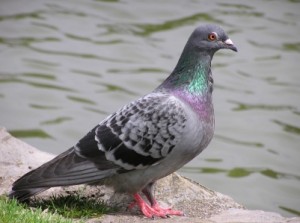Family, Description and Size:
The Rock Dove (Pigeon), or Rock Pigeon as it is widely known, is a member of the Columbidae family of birds. Their feathers have a pale gray color, with two black bars on each wing. There are a few differences between male and female and also the domesticated and feral populations may differ in appearance.
The adult is 11 to 15 inches long, has a wingspan of 24 to 28 inches and weight on average 8.4 to 13.4 oz.
Range and Habits:
At first the Rock Dove existed only in Europe, Asia and North Africa, but in 1606 the species was introduced to North America where it now thrives in great numbers. Its preferred habitat is natural cliffs, usually close to shores, urban areas and farms. The domesticated species of the Rock Dove, which has returned to the wild and thus is called feral, lives in cities.
Feral Rock Doves are known to pollute the city with their feces, as they can be found on statues, lampposts, the high rims of important building and generally multiple storey houses. The feces both can ruin a structure or piece of art in time and they may carry the Avian Influenza Virus. Where large numbers of feral Pigeons exist, they can cause extensive damage.
General Information:
Rock Dove are monogamous and breed at any time of the year, with peaks during spring and summer. A couple produces 2 young each time on average. They nest on cliff faces or artificial cliff faces like apartment buildings. The parents share the burden of incubation. The newly hatched nestling has a pale yellow plumage and a pink bill with a black stripe. The “milk” they feed their young is a substance the parents produce in their crops and offer their young for sustenance. Rock Dove can be domesticated.
Predators, Mortality and Lifespan:
Since its only defense is flying, the Rock Dove has many raptorial bird predators hunting it. This is also true for urban areas where feral Pigeon are hunted by Urban Raptorial Birds. Some of these predators are Peregrine Falcon and Eurasian Sparrowhawks. In North America the main predators of the Rock Dove are Great Horned Owls, Opossums, Red-Tailed Hawks, Eastern Screech Owls, Raccoons and Accipiters.
They also frequent farms and feed lots, causing great concern to farmers due to the feces that is dropped on domestic animal feeding areas. Feed lots, dairies and other areas that raise food for human consumption are often places you can acquire permission to safely hunt the Rock Dove.
Rock Doves carry many parasites that also kill a part of the population. They can also die of famine if the population grows too large and food is not enough to feed all the birds in an area. Their eggs can also be eaten by raptorial Bird predators. Even though it faces many dangers the Rock Dove enjoys a healthy population and is on the Least Concern list of endangered species.

